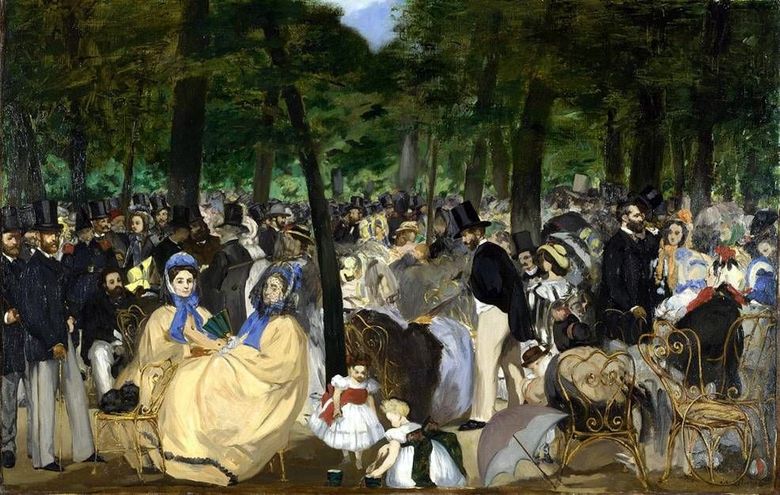
This time, Mane decisively discards all the covenants of Couture, all of his notorious recipes. While portraying a meeting of people, he feels a sense of complete emancipation, writes with his free hand, with light vibrating strokes, works with such ardor and pleasure that he had never experienced before. He does not set out to build this crowd as a single organic mass. He obeys his own temperament – he deliberately emphasizes each silhouette, thereby revealing his contrast with the silhouette of the neighboring one.
The successive alternation of dark and light spots gives a rhythm that informs the depicted scene of movement. The people represented by Manet in the picture are not at all anonymous. In addition to himself and his brother Eugen, they are friends and acquaintances, including well-known people: Baudelaire and Ballerua, Theophile Gautier and Offenbach, Baron Taylor and Prince of Boulevards Aurélien Scholl, a Parisian chronicler who created his famous jokes not so much in newspapers as on the terrace Cafe Tortoni; the writer Chanfleri, a close friend of Mourzhe and Courbet, a passionate preacher of realism, advertising his convictions as his own not-too-neat appearance – matted hair, and his articles and books, written very casually, with endless contempt for “unnecessary beauty of style,” and a spouse “Major” Madame Lezhon, whose beautiful shoulders made you forget about the ugly features of her face; and Fantin-Latour, a young artist, prone to contemplation, silent, even somewhat cold in appearance, a skilled copyist, willingly correcting the picturesque crafts of ladies and young ladies in the Louvre, where Manet is often inferior to wanting to chat with him; and a native of Angers, Zachary Astryuk, in a southerly talkative manner, articulating every syllable in the manner of a professional actor; he tries to join all kinds of art – he paints in oils, sculpts, composes poetry and music, acts as a critic and a journalist. articulating every syllable in the manner of a professional actor; he tries to join all kinds of art – he paints in oils, sculpts, composes poetry and music, acts as a critic and a journalist. articulating every syllable in the manner of a professional actor; he tries to join all kinds of art – he paints in oils, sculpts, composes poetry and music, acts as a critic and a journalist.
The canvas “Music in the Tuileries”, marked by such a heightened sense of modernity, written with such a casual brilliance, with such a “goodness” of a pictorial text, with such extraordinary freshness, revealed the best qualities embodied in Manet’s talent, and the courage he showed here was all the more significant that the artist himself did not realize this courage. What courage is there? He wrote what he saw that caressed his eyes, which despotic ruled them. He simply tried to convey here some of his impressions, if we use the word that now and then speak from time to time in the lips of the artist. He, Mane, was sincere when he wrote, and nothing more. Yes, of course, he was sincere, but also naive. He couldn’t even think that the canvas, born with such happy ease, has an absolute novelty, what is new in it is not only the plot, but to an even greater extent the pictorial handwriting is swift, concise, grasping the most essential, completely corresponding to the plot. And that this novelty will inevitably confuse the viewer. If someone was able to evaluate the “Music in the Tuileries”, then this is certainly Baudelaire. Doesn’t the Music in the Tuileries meet his wishes? But – what a surprise! – Baudelaire congratulates Mane very discreetly.
He doesn’t like canvas, and if he does, he doesn’t. He never imagined the idea of modernity so specifically. “Music” surprises him, even disappoints. She generally disappoints many friends of the artist. All of them skeptically shake their heads, all are somewhat embarrassed: they can not understand the outstanding advantages of this unusual work. Mane is inferior. He expected his “Music” to succeed in the next Salon. But there will be no more talk about it. He still thinks – he has time, – what canvases to write to be accepted. Cool reception did not discourage him at all. After the “Music” is written, he feels that he has gained some unfamiliar strength to this day, as confidence grows in him day by day. His paintings will be accepted at the 1861 Salon; to achieve this is necessary
 Music in the Tuileries Garden by Edouard Manet
Music in the Tuileries Garden by Edouard Manet Cherry Boy by Edouard Manet
Cherry Boy by Edouard Manet Portrait of Emile Zola by Edouard Manet
Portrait of Emile Zola by Edouard Manet Eel and Mullet by Edouard Manet
Eel and Mullet by Edouard Manet Musique aux Tuileries – Edouard Manet
Musique aux Tuileries – Edouard Manet Christ with the Angels by Edouard Manet
Christ with the Angels by Edouard Manet Old musician by Edouard Manet
Old musician by Edouard Manet Flutist by Edouard Manet
Flutist by Edouard Manet